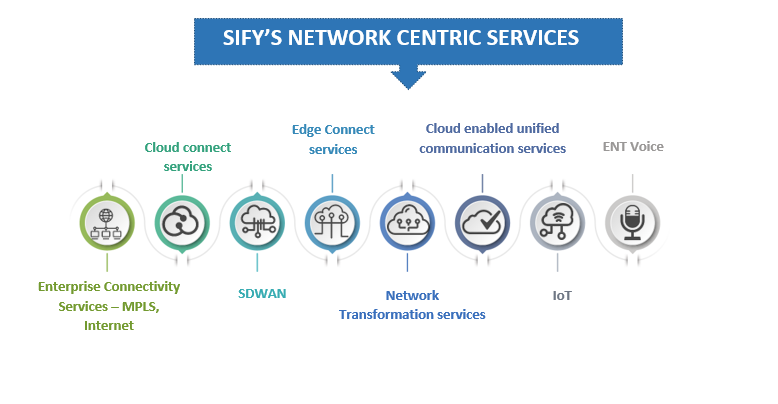How network infrastructure is evolving to support AI workloads
Today’s AI landscape lives in hybrid environments: data centers, public cloud AI services, edge locations, and distributed apps. In this environment, the network becomes the speed, experience, and cost lever.
The future of enterprise networking: Exploring the benefits of SD-WAN
The conversation around networking solutions has reached a critical juncture, and software-defined wide area networks (SD-WAN) have become central to this discourse. The SD-WAN market is projected to reach USD 13.7 billion by 2027, growing at a compounded rate of 31.9% annually. As enterprises demand agile, built-for-purpose, future-ready, cost-effective, and secure networking solutions, SD-WAN represents a preferable alternative to the limitations of traditional networking solutions. This article delves into the transformative business benefits of SD-WAN, its advantages over traditional WAN technologies, and why enterprises must take immediate notice.
What is SD-WAN and how has it evolved?
Consider this scenario: A retail chain with stores in multiple cities, each running different promotions, handling distinct inventory, and serving diverse customer needs. How do they ensure that all of their branches communicate efficiently with the headquarters and with each other? How do they safeguard sensitive data that is exchanged over their network?
SD-WAN emerges as a game-changing solution in these contexts. It leverages software-defined networking (SDN) to establish a more agile and responsive network ecosystem. It dynamically optimizes WAN performance, delivering an exceptional user experience.
Traditional WAN vs. SD-WAN
Traditional WAN architectures offer robust stability, compatibility with legacy systems, and regulatory compliance. Through high-quality connections like MPLS, they guarantee performance where it is critical. Being a widely adopted technology, many organizations have the in-house expertise to manage them efficiently. On the other hand, they are known for their rigidity and inefficiency, often requiring a lot of manual configurations. The lack of centralized management is also a major drawback. All of this results in higher costs, poor performance and lack of scalability.
SD-WAN revolutionizes this space by offering significant WAN optimization. SD-WAN shines in its ability to offer agile, cost-effective, and scalable networking solutions with centralized management. Leveraging software-defined networking, it optimizes traffic routes, prioritizing essential applications for enhanced performance and reliability. Additionally, built-in security features, such as end-to-end encryption, fortify the network, making it an alternative to traditional WAN technologies.
Organizations adopting SD-WAN can expect to reduce networking costs while significantly improving their bandwidth. Its fast, reliable, and secure network can handle any unprecedented surge in users. Centralized management and better visibility keep diverse locations connected efficiently.
Sify’s Managed SD-WAN: Features and benefits
Sify, a recognized niche player in the Gartner Global Managed Services Magic Quadrant, offers a cutting-edge managed SD-WAN platform, developed in collaboration with top OEMs. Sify SD-WAN helps enterprises to meet the evolving network requirements with unmatched agility, security, and scale.
- Improved performance:
Superior application steering, intelligent routing and application prioritization result in accelerated performance, reduced latency, and enhanced user experience.
- Cost savings:
SD-WAN brings down hardware costs and optimizes bandwidth and network assets utilization, helping to derive the best long-term ROI.
- Simplified management:
Centralized control, policy management and automation simplify network management, reducing manual configurations and enabling efficient scaling. Management dashboards offer granular views based on business intent.
- Enhanced security:
SD-WAN security benefits include bolstered overall network security, encrypted traffic and secure connections for remote offices.
- Application awareness:
SD-WAN excels in application-aware dynamic bandwidth allocation, particularly useful in high-demand scenarios. Pre-configured SD-WAN policies can immediately identify and prioritize latency-sensitive traffic to ensure there is no degradation in quality.
- Automatic failover:
SD-WAN’s intelligent algorithms detect congestion or failure on the primary connection, and they automatically switch traffic to a secondary connection, ensuring uninterrupted user experience.
For more insights into a best-practices-driven SD-WAN implementation, click here to learn how Sify’s SD-WAN services combine robust performance with cost-effectiveness.
Emerging trends: The future of SD-WAN
SD-WAN as-a-Service: Managed SD-WAN deployments are growing rapidly, with more enterprises choosing to outsource WAN management to specialized service providers. By 2020, this number had risen to nearly 50%, from just 8% of deployments in 2017. There has been a noticeable shift towards offering SD-WAN as-a-service, with businesses able to adopt this technology without hefty upfront investments.
SD-WAN and Secure Access Service Edge (SASE): When integrated into a SASE framework, SD-WAN benefits from an additional layer of security, which makes policy-based, secure access to network resources efficient and highly secure. For example, SD-WAN enhances secure remote access by providing encrypted pathways between remote locations and central networks. To add to this point, the focus on zero-trust security models further boosts SD-WAN’s credentials as a secure networking solution, by ensuring that all traffic is verified before access to the network is granted.
SD-WAN and Cloud: Traditional WAN architectures often struggle to efficiently route cloud-bound traffic, leading to suboptimal performance and potential security risks. SD-WAN dynamically routes traffic based on application type, quality of service requirements, and network conditions. It can identify the most efficient path to a particular cloud service and optimize the route for performance, reliability, and security. Furthermore, SD-WAN solutions often have native integrations with major cloud service providers. Such “cloud on-ramp” capabilities empower SD-WAN for rapid and secure cloud access.
SD-WAN and AI: AI-driven automation is enhancing SD-WAN by enabling smarter traffic management and improved security through anomaly detection. By integrating AI and machine learning, SD-WAN becomes capable of intelligent network optimization and predictive analytics. A unified approach (often enabled by a single management console) consolidates heterogeneous networks and traffic onto a single platform for easier management and also serves as a rich source of network and security data.
SD-WAN and the Edge: SD-WAN enables near-real-time data processing and analysis at the source, reducing latency and boosting application performance. Its dynamic traffic routing capabilities also enhance efficient data handling at distributed edge locations, allowing organizations to deliver timely insights and actions.
Conclusion: Key considerations for implementing SD-WAN
SD-WAN will play a pivotal role in the next wave of digital transformation. Organizations that are considering the switch should begin by assessing their needs and choose an SD-WAN solution or a service provider who can offer the full suite of capabilities suited to these needs.
Sify delivers a managed SD-WAN platform that enables the network agility and security needed by the modern-day enterprise. Sify’s SD-WAN platform supports customers’ network needs across a multi-service provider and multi-media environment. Learn how you can empower your network with our SD-WAN services. Learn more
Role of Enterprise Managed Wi-Fi in the Era of IoT and Smart Devices
In the rapidly evolving landscape of the Internet of Things (IoT) and smart devices, reliable and efficient connectivity is paramount. Managed Wi-Fi services play a crucial role in enabling seamless communication and data exchange between IoT devices. The explosion of mobility & BYOD, enterprise virtualized applications moving to the cloud, increased use of multimedia-rich applications within the enterprise, and infrastructure modernization are a few of the core business drivers for increased adoption of enterprise managed Wi-Fi services.
With unprecedented advancements in IoT, data modeling, and AI/ML, there is a consistently growing focus on edge computing and its benefits. Enterprises are accelerating efforts to move to the cloud for on-demand computing, capacity, scale, better reach, scalability, and higher availability. Additionally, the managed Wifi services eliminate the traditional Wi-Fi challenges like lack of uniform access policy, no visibility into the wireless network, inadequate protection against wireless threats, complex or tedious onboarding process, and lack of visibility on user groups.
According to Marketsandmarkets, the global edge computing market size as per revenue surpassed $44.7 billion in 2022 and can rise to $101.3 billion by 2027 at a CAGR of 17.8% for the forecasted period (2022-2027).
This blog explores the significance of Enterprise Managed Wi-Fi services in supporting the proliferation of IoT and smart devices, the challenges they address, and the benefits they bring to businesses and consumers.
- Connectivity and device management
Managed Wi-Fi services offer a fully managed, secure wireless platform integrating Information Technology (IT), Operation Technology (OT), and people. It provides a robust infrastructure for connecting and managing a multitude of IoT devices. It offers a cloud-based centralized management platform with control and monitoring capabilities enabling enterprises to configure and manage their IoT devices efficiently. From provisioning and onboarding to security protocols and firmware updates, these services streamline the device lifecycle, reducing operational complexities and enhancing overall device management. - Security and data protection
Managed Wi-Fi services enable a security posture which is crucial in the IoT landscape. The managed Wi-Fi services offer robust security features to protect IoT devices and the data they generate. By processing sensitive data locally or within a private network using network segmentation, edge devices can minimize data exposure to potential cyber threats as they’re isolated from other network resources. Managed Wi-Fi services also enable regular security updates and patches to address emerging threats, enhancing the overall security posture of IoT deployments. - Bandwidth management
With the growing adoption of connected devices, scalability becomes a critical factor as transmitting a large amount of data to the cloud for processing can strain network bandwidth and incur significant costs. Enterprise Managed Wi-Fi services are designed to handle large-scale deployments enabling enterprises to seamlessly scale their IoT networks. Enterprises can prioritize critical applications and optimize network resources using advanced bandwidth management techniques to ensure IoT devices receive the optimal bandwidth for their operations, preventing congestion, maintaining smooth communication between devices, and more efficient network utilization. - Reliability and performance
IoT applications and Smart devices often require real-time data exchange and low-latency connectivity. Managed Wi-Fi ensures high reliability and performance for IoT devices by optimizing network configurations and minimizing interference. They employ techniques like load balancing, channel selection, and Quality of Service (QoS) prioritization to maintain a stable and responsive Wi-Fi network. Edge computing reduces the latency required for sending data to a remote cloud server for processing. By processing data at the edge of the network, closer to the devices generating the data, response times can be significantly reduced. It is important for applications that require real-time or near-real-time processing, such as industrial automation and remote monitoring. - Analytics and insights
Enterprise Managed Wi-Fi enables real-time analytics into network performance and device behavior, giving enterprises decision-making capabilities at the network edge. They collect and analyze data on network traffic, device connectivity, and usage patterns, offering actionable intelligence to optimize network resources and improve overall IoT operations. These insights can help identify potential bottlenecks, optimize device placement, and enhance user experiences. Additionally, analytics-driven predictive maintenance can proactively detect and address anomalies, reducing downtime and increasing the lifespan of IoT devices. - Scalability and cost-efficiency
Edge computing allows for distributed computing resources, enabling scalability and cost-efficiency. Instead of relying solely on centralized cloud infrastructure, edge devices can share the computational load and distribute the processing tasks. It can result in reduced network congestion, lower costs associated with cloud resources, and improved scalability to accommodate the increasing number of IoT devices and data volumes.
Wrapping up!
With the growing digital landscape and IoT integration across enterprises, the need to deliver secure, seamless customer and employee experiences become a top priority. Enterprise Managed Wi-Fi services provide a reliable and secure connectivity infrastructure to deliver seamless device management, ensure scalability, optimize network resources, quick & accurate decision making, enhanced production planning, logistics, complete mobility for your workforce, and lower IT support costs.
As the IoT landscape continues to expand, Managed Wi-Fi services will remain crucial in delivering seamless and efficient connectivity for a wide range of applications, enhancing productivity, efficiency, and user experiences.
Hyper Scale Network
Hyperscale Networks
For the new-age infrastructure, Hyperscale means the ability of the architecture to rapidly scale up to match the increasing demand of enterprise workloads. Hyperscale infrastructure relies on high bandwidth and high availability, especially for key data center sites. In this document, we talk about Hyperscale Cloud, Data Centers and how Interconnection Networks enable a seamless connectivity bridge for executing the Hybrid Cloud Strategy.
Download whitepaper
Re-Architect your Network with Sify
Integrate your Cloud, Core, and Edge
With the advent of IoT, pervasive mobility, and growing cloud service adoption, the network has become increasingly distributed, and the need for faster compute and connectivity at the edge has become more pronounced.
As organizations increasingly drive digital transformation initiatives and adopt hybrid multi-cloud, the network must be rearchitected to support new-age topologies. Hence, Network Transformation gains predominance. Network Transformation and re-architecture must play out at all the 3 points of presence of the Network – at the Network Core, Network Management layer, and the Network Edge.
Let us look at the significance of the Transformation at these 3 layers and the contribution that Sify is bringing at each of these points of presence.
Transformation at the Network Core
With Cloud adoption, Data Center is no more the Core of the network. As enterprises are moving their applications to the cloud on consumption-based models for enhanced business productivity, it has become important to secure connectivity to the Cloud and extend the Quality of Service to a hybrid multi-cloud environment. Hence, the transformation of the network at the Core is essential for improved agility, enhanced productivity, and scalability.
Sify’s Transformation Services at the Core are designed to help customers harness the true potential of cutting-edge cloud, digital, and network technologies. We help our customers accomplish their transformation goals and meet dynamic business requirements capably by providing Cloud Interconnect networks, which enable customers to establish direct connectivity between their private and public cloud infrastructure and fully realize the benefits of hybrid cloud architecture. With our Hyperscale Cloud partnerships and the Cloud Interconnect Networks, combined with expertise to deploy technologies like SDWAN & NFV, we hold a distinct level of expertise in network integration and transformation for a hybrid multi-cloud environment.
Transformation at the Network Management and Control Layer
As networks become more & more complex, organizations nowadays are leveraging multiple network service providers, and they have distributed nature of applications and end-users. This has resulted in a very complex network architecture. Moreover, monitoring and management of these complex and distributed networks and network elements have become very critical. Network Management & Control requires a distinct level of expertise, advanced tools, and automation platforms, and hence makes good business sense to outsource the management to an expert who has the benefit of scale, experience, and toolsets to deliver the same. The customer can in turn focus on his core business.
Empowered with a robust Network Operating Center, Sify offers a wide spectrum of Network Consolidation, Network Transformation, and Operations Outsourcing solutions. Sify can manage customer’s as-is WAN network architecture, provide 24×7 monitoring of links, undertake incident management, change management, and can yet ensure unified SLA management across multiple service providers in a single-window provision. Not only this, but Sify also helps customers in network study & assessment and consulting for Network Re-Architecture and Managed Services.
Transformation at the Network Edge
Network Edge is the bridge between an organization and its end customers to deliver enhanced user experience and employee productivity. It is a strategic gateway to connect widely distributed organizations. The traditional networks cannot accommodate the new IoT devices, sensors, and plethora of Edge devices that are connected and managed at the Edge. Therefore, it is crucial to adopt transformation of the network at the edge to meet the requirements of the end devices and make them an integral part of the Enterprise Networks.
Sify Edge Connect Services include advisory services like an assessment of customer requirement with respect to coverage and performance. Further, we ensure end-to-end implementation of customer’s WiFi network, which includes configuring guest access and incorporating employee authentication & access. Our highly secure platform provides insight into user patterns and analytics such as the location of users, applications browsed, etc. Sify also provides deep visibility and control of the performance and usage of applications. In addition, Sify Edge Services include IoT services and aggregation and integration of the same with the Enterprise Network.
While rearchitecting your network, it is important to include aspects connecting the above three points of presence of users and applications. This will help you architect a network that delivers efficiency and is future-ready. However, the majority of organizations lack the necessary skills and expertise to envision and manage such a complex transformation, and that is where Sify Technologies can be your partner in this transformation journey.
What makes Sify the preferable partner for Network Transformation?
Sify is the largest Information and Communications Technology service provider in India, serving 10,000+ businesses across multiple industries with its impeccable Cloud and Data Center services, Network services, Security services, Digital Services, and Application Services. Our industry-wide experience of working with diverse clients, skilled workforce to manage varied network transformation projects, and the Technology Partner ecosystem, makes us the most trusted Network Transformation partner for India Enterprises.
Today, Network Integration, Network Transformation, and Managed Services are the key differentiators. That’s where Sify can help businesses achieve their strategic goals. As a strong, capable ICT transformation partner, Sify brings in the integrated skillsets, processes, and tools that are required for a seamless transition in a cost-effective way. Add to this, Sify’s engineering capabilities are the best in class and help our customers design innovative solutions that are custom-built to suit their business needs.

Simplify Your Network Transformation
Simplify your Network Transformation with Sify
The business world is witnessing an unprecedented transformation as organizations across verticals are passionate to embrace new technologies. Cloud, Analytics, Automation, Internet of Things, Artificial Intelligence, and Machine Learning are some major forces that are enabling enterprises to deliver a top-tier experience to customers. As organizations nowadays are highly reliant on these emerging technologies to achieve organizational excellence, one must acknowledge that all cutting-edge technologies require an intelligent and robust network. There are numerous factors that are fundamentally redefining the ways new-age networks work and function. The emergence of new global trends and multiple new technology trends have compelled organizations to demand more from networks. This blog discusses:
- Major global and technology trends that have paved the way for network transformation.
- New-age network architecture and design for Intelligent Network services
- How Sify can help you in your network transformation journey with a wide range of Intelligent Network Services.
Global Business Trends leading to increased demands from Networks
- Hyperconnected Enterprises:
In the digital age, global organizations rely on a multitude of connections for geographically distributed people, processes, and devices. Also, the increasing adoption of hybrid and multi-cloud has compelled global enterprises to become hyperconnected. For such hyperconnected enterprises, a scalable network is quite critical to deliver top-tier services to customers across the globe through digital technologies. - Digital Business Transformation:
In line with their digital ambition, organizations worldwide are looking to leverage Cloud-native technologies such as analytics, mobility, IoT, AI, and ML to modernize and develop new processes, services, and models for generating new revenue streams. An intelligent and adaptable network can quickly adjust according to evolving requirements, facilitating seamless transformation. - Automation and Robotics:
Several enterprises rely on Automation, Robotics, and Robotic Process Automation to improve operational efficiency, quality of services, and customer satisfaction score. The use of Automation and Robotics in the coming years will continue to surge as companies look to improve quality, workforce productivity, customer satisfaction, and more. This is even more relevant than ever in the pandemic-stricken world. As automation of processes is time-sensitive and mission-critical, enterprises will need round-the-clock availability and reliability from their distributed networks as even a minor lapse in network availability or reliability can potentially hamper the process flow and affect overall efficiencies and customer satisfaction.
Technology Trends powering fundamental Network Transformation
- Applications being modularized and distributed across Clouds: Recently, hybrid Cloud and microservices have gained massive prominence across business verticals. The majority of software applications are being modularized and distributed across public Clouds and network edge. To support applications across such a distributed landscape, the network needs to transform fundamentally. There is a need for Networks to be agile, seamless, secure, and responsive to dynamic application landscapes.
- IoT and M2M integration with mainstream Networks: The exponential rise in the number of IoT devices worldwide highlights the need for smart Machine-to-Machine communication. This means the network must capably provide connectivity to all the IoT devices and integrate them smartly with mainstream networks.
- Pervasive Mobility: Owing to the anywhere data center and anywhere user access, there is a need for a robust network to allow users to access applications on Cloud. As anticipated, mobile users will continue to grow in the years to come and they would need round-the-clock high-performance connectivity to access applications on Cloud from private devices over Wi-Fi or 4G networks. Therefore, to cater to this rapidly growing mobile population, it becomes imperative to strengthen the Edge connectivity to these vast diverse, and distributed user base. Edge Transformation is predicted to be the next big wave in the Networking space. As per Gartner – by 2025, 75% of enterprise-generated data in industrial settings will be created and processed at the edge.
- Immersive video experience: User experience has taken the center stage in the digital era, therefore enterprises are keen to make the video experience more immersive. They have started leveraging the power of digital media technologies, Virtual Reality, Augmented Reality, and immersive 3D environments to ensure a top-tier experience. This is placing greater demands on enterprise networks as video experience is totally dependent on low-latency and high availability infrastructure. Moreover, enterprises also want their networks to provide end-to-end bandwidth and dynamic performance controls to further make the experience more enriching.
New-age network architecture and design for Intelligent Network Services
In response to emerging trends and the fast-changing IT landscape, organizations need to rethink network architecture and design strategies to drive digital transformation. It becomes quite critical to align network capabilities in accordance with the changing business requirements and modern topologies. In this light, some of the expectations from Intelligent Network Services are the following:
- Support the fast-changing set of users, applications, devices, and services and unify them intelligently for top-tier user and application experience
- Seamlessly connect between distributed IT assets and applications in a DC and hybrid multi-cloud environment
- Leverage Software and other functionalities to control, rather than physical access and distributed policy control
- Leverage the cutting-edge technologies and algorithms to collect, assimilate, analyze, and visualize networking information in real time for better visibility and control
To achieve the above objectives, there are 3 broad aspects that the IT leaders must follow while designing and architecting the new-age network architecture.
Networking architecture for anywhere Data Center:
Organizations nowadays have their applications and data spread across Data Centers, Clouds, and Edge environments in diverse geographical regions. To meet the requirements of this diverse hybrid ICT landscape, organizations need new networking architecture that is ready for Cloud, meets application connectivity demands, and ensures technology and operational consistency across locations. Therefore, the new-age network must facilitate faster and safer modes of data transfer across Data Centers, Cloud, and Edge devices. This highlights the significance of Cloud-ready Networks with DC Interconnects and Cloud Connect capabilities.
Being a trusted ICT company, Sify ensures a Cloud-ready Network, comprising of Data Center Interconnects, Hyperscale Cloud Connects, and Internet Exchanges for carrier neutrality. Our Cloud-ready Network provides you with deterministic and secure connectivity to move applications, middleware, and database workloads between private infrastructure and Cloud for improved application performance.
Hybrid WAN and Application performance-focused Network Architecture:
In the age of hybrid and multi-cloud, it becomes critical for organizations to have a well-thought-out network strategy for distributed workloads, data footprints, applications, services, and microservices. With the rise in multi-cloud adoption, the legacy hub-and-spoke WAN architecture can hold organizations back. The shift from Data Centers towards Cloud has resulted in the more prevalent use of the SLA-defined Internet (in addition to MPLS) as a reliable and pervasive way to establish robust connectivity. Hence, modern-day businesses need a hybrid WAN strategy – the use of internet for business applications along with MPLS. This means the new-age network must enable the hybrid WAN and be smart enough to adapt to the changing application performance demands in a hybrid or multi-cloud environment, ensuring better performance.
Herein, Software Defined Networking can enable fundamental network transformation. SDN can help accomplish the goals of network transformation – agility, flexibility, and application centricity – by intelligently controlling the network architecture using software applications.
- Software Defined Networking facilitates flexible network architectures, which can utilize multiple network connectivity options (MPLS/ILL/BB/4G-LTE/Internet) which help leverage a Hybrid WAN strategy for the evolving DC and Cloud landscape
- SD-WAN ensures application awareness and complete visibility of site-wise utilization of various applications, which paves way for better performance, availability, and security.
- SD-WAN leverages the power of Cloud-based monitoring and management platform for centralized, real-time visibility of all resources.
- SD-WAN solutions can be easily integrated with legacy network architectures, which enable phase-wise migration of sites.
Sify’s SD-WAN platform is hosted in Secure Cloud, and our experts perform all the monitoring and management functions from the state-of-the-art NOC. This helps you maintain distance with different configuration tasks at branch sites and focus on your core business. Our SD-WAN solutions – coupled with end-to-end Managed Network Services – drive efficiencies, reduce cost, and optimize multi-cloud connectivity.
Centralized visibility, control, and insights of the Network:
Organizations need complete visibility and control over network connectivity to make the most of their Cloud investment. They would also want their network to provide intelligent insights that enable data-driven decision-making. An intelligent network can help businesses with automated and effortless orchestration of network resources. However, enabling a network with comprehensive intelligence is not as simple as it seems, because it requires a well-established network management practice with well-integrated toolsets.
Currently, only a few network service providers, such as Sify Technologies, have the assets, capabilities, and expertise to deliver Intelligent Network Services. We ensure centralized management of the network, powered with the capacity of SDN, to bring in the highest level of visibility and control of the entire network landscape. We offer a comprehensive range of Network Management Services on flexible outcome-based models – shared NOC Services, Hybrid NOC Services, and Dedicated NOC Services – from our state-of-the-art Network Operating Center.
Sify’s network experts ensure 24×7 proactive monitoring and management of network connectivity of devices such as routers, switches, and firewalls, and provide comprehensive reporting of various network parameters such as availability, performance, and security.
Conclusion
The emerging business and technology trends have compelled enterprises to empower their network with inherent intelligence built into them. This needs fundamental network transformation and re-architecting from the ground up, to suit evolving DC and Cloud landscape, distributed/mission-critical applications, and network orchestration needs.
Being a strategic network transformation partner, Sify helps you transform your network into a robust and intelligent asset. We provide Intelligent Network Services which include Cloud-ready Networks, Software-defined WAN, and centralized Network Managed Services, to accelerate your digital transformation with the robust foundation of a fast, secure, and future-ready network.
Consolidate your Network with Sify
Rationalize, Scale, and Manage your network effortlessly.
In today’s technologically advanced era, enterprises across realms have complex ICT environments – virtual and geographically spread. The advent of Cloud and rise of multiple solution providers globally have encouraged organizations to pick and choose the perfect mix to host their applications, servers, and data across a diverse landscape of Data Centers and multiple clouds. This has benefitted organizations worldwide, in terms of ease of operations, higher level of flexibility and better speed to market. However, at the same time, one must acknowledge that management of such a highly complex ICT environment has become a major challenge for many organizations in the digital era.
Organizations must understand that all the components of their diverse IT and network infrastructure – consisting of applications, servers, machines, network peripheral equipment, sensors, or even distinct Cloud environments – are not discrete or isolated units anymore, but a part of a larger organization context, making them extremely valuable for business progression and business continuity. All these components must be unified and viewed in a consolidated way for better performance and security. That’s where, Network Consolidation becomes imperative!
Organizations that have complex ICT environments face distinct challenges that hamper their overall performance and efficiency. Some of the most common challenges in this changing and ever evolving Network and IT environment are:
- Multiple service providers management: Modern enterprises leverage a perfect blend of best-of-breed network solutions from distinct service providers as this ensures advantages of redundancy, resiliency, choice of network media, and connectivity to remote locations. However, managing all the distinct service providers is quite a challenging task and has some inherent problems, such as lack of ownership and visibility, inconsistency in services, inability to leverage analytics, and governance related risks.
- Limited in-house network management capabilities: This is another major concern for organizations across industry verticals. If they opt for establishing an in-house network management setup, then it becomes a very cost-intensive decision to hire the skilled workforce, procure the technology, develop the competence, and achieve a high level of scalability. Furthermore, an in-house setup would need hefty and timely investments to keep pace with evolving technology landscape.
- The demand for constantly re-architecting network: Every enterprise network nowadays has a host of different applications, which has given rise to changed traffic patterns. These mission-critical applications demand uninterrupted collaboration and traffic exchange, which calls for a continuous re-architecting of network to connect data, applications, people, and varied components of the IT infrastructure.
- Shift of focus from Network uptime to Application performance: Traditionally, network has always been uptime-focused, however in current situation where applications are hosted in multiple of Data Centers, Public & Pvt Clouds, businesses are more concerned about how applications perform over the network as this directly impacts the end user experience. The changing demands of high-performance computing and fast cloud migrations have led to a change in paradigm for networks with their SLAs being evaluated on Application intent rather than Network intent. Therefore, new-age networks must capably meet the rising needs of all mission-critical applications that are running concurrently.
- Unification of underlay and overlay networks: To meet changing demands of businesses, networks have grown and evolved organically over different periods of time. This has resulted in complex architectures of underlay & overlay networks. With changing priorities of organizations and rise of application-focused networks, it is important to unify the underlay and overlay networks for optimal utilization, enhanced efficiency, improved user experience, and robust security.
- Connectivity across DC and Cloud landscape: With increased Cloud adoption, it is very important to maintain a perfect sync between data centers and Cloud. Therefore, they need an excellent Network Interconnection that can guarantee seamless connectivity across all the data centers, Cloud environments, international cable landing stations, third party telco infrastructure, etc. for deterministic connectivity and extensive reach.
- Integration of IT, OT, and People: Majority of organizations nowadays have geographically distributed offices, where employees and end users use multiple devices in different regions. It is important to allow them secure and fast access to applications in Cloud and data centers for better experience, collaboration, and organizational efficiency. At the same time, the same Network must ensure seamless connectivity of IT Infrastructure as well as OT assets like WiFi access points, IoT devices and sensors. Herein, network plays an important role in integration of all aspects of IT, OT, and people.
As discussed above, organizations with complex ICT environments face distinct challenges. This not only hampers efficiency and performance but also impacts end user experience, hence compelling organizations to revisit their network strategies. Enterprises want actionable information to be available to end users wherever they are. The rise in mobility and multitude of devices has paved way for direct access to corporate information, which highlights the need of secure and consolidated network which can be scaled rapidly on-demand. The CIOs need to have complete visibility of all network assets and take decisions on network performance and network behavior dynamically. This can be achieved only through network consolidation.
Consolidating your network under one trusted service provider will ensure you a centralized real-time visibility and control over your entire network. Network consolidation improves network performance management and makes network provisioning easier with lesser handoff points between providers, devices, and IT assets, at a reduced cost!
Network consolidation becomes a very complex task and it has a lot of parameters and moving parts to be looked into. Therefore, it is imperative to seek an expert guidance in this quest.
Sify can help you accomplish your Network Consolidation goals. Some of the key differentiators that make us the preferred network consolidation partner are:
- Hybrid Network Strategy – Use of Internet for Business Applications: The shift from data centers towards Cloud has resulted in more prevalent use of the Internet as a connectivity option, in addition to MPLS. Today, an SLA-defined Internet strategy is a more reliable and pervasive way to establish a robust connectivity throughout the widely spread ICT environment. Hence, modern day businesses need hybrid WAN strategy – use of internet for business applications along with MPLS. Sify is empowered with India’s largest MPLS Network covering 1,600 towns and cities across India with 3,100 Points of Presence. We provide consistent, secure, high-speed Internet connectivity in more than 130 countries together with 800+ local and global partners. With our robust MPLS and Internet services, we can help you consolidate your network for both primary and secondary connectivity needs.
- Cloud Ready Networks – Advantage Hyper-scale: As majority of modern enterprises opt for hybrid or multi-cloud model, enterprises need ubiquitous connectivity to data centers and public Clouds. Sify’s robust interconnection network helps enterprises connect and integrate with Hyper-scalers seamlessly to simplify Cloud connectivity and reduce provisioning time. Our interconnection network improves cross-cloud application interaction, performance, and scalability, which ultimately paves way for enhanced quality of experience. Sify enjoys a great stature in the India Cloud market as we are the preferred partner of all major Hyper-scalers such as AWS, Azure, Oracle, and GCP including their respective Cloud connect services. With our Cloud connect, DC Interconnects and carrier neutral network with multiple internet exchanges, we deliver a well-architected and cost-effective Cloud-ready network for a secure, low latency and deterministic connectivity.
- Strategic Move from Wireless to Wireline Connectivity Media – More relevant than ever: Today, convergence of wireless and wireline is happening at a lightening pace. Till now, fiber penetration was restricted to backbone networks in the network value chain; however, as we move to the hyper-connected era, networks fiberization becomes important for the increasing cloud adoption. Therefore, Sify has invested in dense fiberization in backhaul and last mile connectivity. Sify’s state of the art 100G ethernet infrastructure – Metro-XConnect integrates multiple Clouds, our Cloud-adjacent data centers, third party data centers, and transit points in the Network. Our investments into Metro-XConnect can help customers consolidate their networks and leverage multiple benefits of Cloud, such as low latency, high reliability, improved scalability, and uninterrupted operations.
- Strong Managed Services and Network Operations Outsourcing capabilities: Empowered with strong Managed Services and Network Operations Outsourcing capabilities, Sify can help you integrate, consolidate, and transform your networks across varied ICT environments for visibility, control, and easy orchestration. Our integrated skillsets, processes, toolsets as well as the state-of-the-art Network Operations Center (NOC) and Security Operations Centre (SOC) can enable you to monitor and manage network and security devices comprehensively. Our NOC services are SLA-driven and outcome-based, which ensures predictable performance. Sify also helps in assessing & consolidating WAN networks; redesigning & reengineering as-is WAN network; and managing Network and Network assets 24X7. Additionally, you can outsource your Network operations and management, including management of all service providers and vendors.
- Integrated capabilities across Core, Management Layer, and Edge : In the digital age, enterprises need to focus on faster compute and Edge connectivity. To accomplish this goal, it is important to transform and rearchitect your network – at the core, the management & visibility layer, and the Edge. With our DC and Cloud Interconnects, combined with expertise to deploy technologies like SDWAN and NFV, we hold expertise in network transformation at the core. At the Network Management layer, Sify can manage your WAN, provide 24×7 monitoring of links, undertake network management under a unified SLA across multiple service providers. At the Edge, Sify ensures end to end implementation and access configuration of Wi-Fi, IoT devices and integration with the Enterprise Network.
Key Advantages Dedicated Web Server Hosting
Are you in search of the best application hosting? Well, choosing the best-dedicated server for your enterprise could be a task in itself. But why dedicated web server? A dedicated web server ensures resilience and resources to host a web application.
Selecting a dedicated server which is fast, secure, properly managed, and has the perfect software tools is very much essential for the growth of your business. A company looking forward to having more control and power will opt for a service provider who offers dedicated server hosting. The server is built and maintained by the provider, thus cutting down the cost of purchasing your own server.
So, let us take a sneak peek into the advantages of choosing a dedicated server hosting provider and some other useful tips in getting started with your new dedicated server.
Advantages:
- High Performance and SecurityHow can you maximize the uptime for your website or application? It is through a dedicated hosting provider. Dedicated servers provide more reliability and stability than the shared hosting. It makes sure that you are not sharing your space with any other malicious software or a potential spammer. Dedicated server leads to enhanced security, this is the reason it is essential for companies taking transactions over FTP or SSL. Moreover, the best-dedicated server hosting comes with 24×7 support to deal with failures and complaints which further ensures high uptimes.
- FlexibilityA dedicated server comes up with flexibility, as you can always customize your server as per client’s requirements of RAM, disk space, CPU, and software. If you want a customizable server environment, then a dedicated server might fit your needs.
- Server Resources are not sharedChoosing a dedicated server fetches you all the resources of a server. With a dedicated server, your server won’t slow down, as there are no other applications sharing your space and clogging up the server’s RAM and CPU. In case of dedicated hosting, your server bandwidth is only yours.
- No Purchase and MaintenanceIf a company requires a dedicated hosting, and it does not have the time and resources to manage a server, the dedicated hosting is a low-cost way to access the resources of the server. Dedicated server hosting helps in maintaining the server equipment, thus reducing the overhead for a business.
- Full ControlOne of the most widely held benefits of dedicated hosting is that you have full control on your server. You decide which site management tool and application you wish to deploy, provided your hosting provider can service them.
Factors to Consider while Purchasing Best Dedicated Server Hosting Plan
Developers and business owners try to find the best-dedicated server hosting because they can be configured easily in order to quench the programming requirements, server load support, and top-notch security. So, here are the points which should be kept in mind before purchasing a dedicated server hosting plan:
- Different types of RAM- Primarily used is DDR3, DDR4, and ECC options in present
- Focus on CPU Benchmark Performance- Know the difference between Xeon, Atom, and Opteron product lines
- Choice of Bandwidth and Data Center Concerns- Internet Backbone Network Speeds, Power Supply, and Cooling
- OS- Windows and LINUX; and choosing between different LINUX distributions
- Technical Support- the capability to support your clients
- Disk Drive Storage- HDD vs Solid State Drives (SSDs)
Almost all the users of dedicated servers yearn for the best hardware configurations at the lowest possible price. However, some choose to bargain on the older equipment available at a particular discount. Legions of mobile applications that come with custom code require complex web server that shared hosting plans do not support. However, it is advised that the business owner should consult with their system administrator to discover the development requirements for their productive applications. Novice development in cloud hosting may soon have an upper hand over the dedicated server plans, and cheaper cum better plans are available on VPS plans with more resource allocation. Hence it becomes quintessential, as how to keep your online business up to date in a rapidly innovating web hosting industry.
Focus on your core business and outsource the complexities of Data Center management with Sify
Network Security, the key to VoIP adoption
With growing Internet infrastructure and new technologies, VoIP (Voice over Internet Protocol) has gained tremendous popularity among businesses. Regardless of size and industry, organizations are migrating their communication network from traditional PSTNs to VoIP. The wide-ranging benefits of the system are bound to attract businesses from across the board – reliability combined with steep cost savings and a plethora of productivity-enhancing features make it the communication network of choice for enterprises.
But, in today’s landscape of increasing cyber-attacks, VoIP must also strengthen its security protocols to ensure businesses are not left vulnerable to malicious cyber agents.
Main Security Threats faced by VoIP
VoIP networks are open to the following threats
- Identity and service threat – this usually involves eavesdropping and phreaking – Eavesdropping is a scenario in which attackers infiltrate the VoIP lines to listen in to conversations to gain access to sensitive business data or private information and accounts to carry out corporate sabotage or identity theft. Phreaking is a term used for the practice of passing off call charges to other accounts by getting unauthorized access to their VoIP service.
- Viruses and Malware – the bane of all Internet-based services – VoIP services are also open to attacks by malware, worms, and viruses.
- Denial of Service – Another threat that is used most often against Internet-based services – DOS can bring the communication network to a halt by flooding it with unnecessary messages.
- Call tampering – call tampering refers to the practice of interrupting the call by injecting noise packets in the network or withholding call packets to cause call delays and poor call quality. Call hijacking is another form of call tampering in which an outside party enters the call and tricks the person on the other line by masquerading as the original caller.
How are VoIP service providers countering these security challenges?
Service Providers understand that the continued popularity of VoIP services depends, to a large degree, on how secure and comfortable businesses feel while using these services. The VoIP providers and organizations have given top priority to securing their communication networks and have spent the considerable amount of effort and money in putting together some of the most cutting-edge security solutions to safeguard their systems.
The threats listed above can be taken care of by a judicious mix of preventive measures –
- SBCs (Session Border Controllers) – SBCs manage VoIP protocol signals and with in-built security firewalls they are the first and one of the most effective lines of defense against cyber threats.
- Anti-virus – installing and operating an updated anti-virus or anti-malware on all connected computer hardware is especially important as they can enter the VoIP network through unsecured channels.
- Encryption – usually provided by the service providers as an add-on service to secure the network and is highly recommended for enterprise users. VoIP encryption is especially important when the organization has many users connecting from outside the office network – from mobiles or from home devices.
- Call restrictions, authorization, and passwords – businesses must restrict access to the VoIP network by making sure that only the required people are given access to the network. This along with call restrictions, to track and monitor call activity and stringent password policies can ensure that people within the organizations are made aware of the importance of keeping the network secure.
- Deep Packet Inspection (DPI) – DPI monitors the network and can identify extra or fraudulent data packets and flag them for review.
- VoIP authentication protocols – the most stringent of these protocols is the so-called three-way handshake – Challenge-Handshake Authentication Protocol (CHAP) uses a three-step process to test the legitimacy of the incoming messages and is far superior to basic password protection which is widely used.
Conclusion
While the future of VoIP services is secure – the benefits of the technology ensures that – security concerns that have dogged all Internet-based services are also giving network engineers sleepless nights. From cloud platforms to on-premise IT infrastructures, all systems have vulnerabilities that can be exploited and as Cyber-attacks become more aggressive and better organized no one is truly safe.
It is estimated that the global cost of cybercrime will reach $2 trillion by 2019 – keeping these numbers in mind organizations can no longer count on just plain old luck to keep their businesses safe, they need to be prepared for the worst. And this is especially true for mission-critical functions like communication!
Here, VOIP is clearly the solution of choice for organizations looking for a secure communications network.
Traditional vs VoIP- What’s best for your business?
As more and more businesses, both big and small, are jumping on the VoIP (Voice over IP) bandwagon, it is interesting to examine what is causing this exodus from the traditional alternative of PSTN (Public Switched Telephone Network) including Mobiles and Landlines.
In order to understand the reasons for the switch, it is important to first appreciate what is significant for these businesses while opting for a communication system. The chief concerns for businesses, irrespective of their size, while choosing a network are,
- How to reduce costs and at the same time not compromise on the quality of the communication system.
- Is there a way that would improve communication with customers and employees and better connect them?
- How to achieve more value for your money and get additional features at the same cost.
- Can the communication system contribute to an increase in efficiency and productivity?
As VoIP addresses these concerns and provides a powerful tool for businesses to ‘up their game’, enterprises in increasing numbers are opting for this alternative.
Cost-Effective Choice
A VoIP solution has a definite edge over its PSTN alternative as it offers free CUG (VoIP-to-VoIP) calling for both local and international. The calls made to mobile and landline phones through VoIP have nominal subscription fees as against a much more expensive PSTN alternative. The sound quality is continually improving as the technology is evolving, providing superior communications and better filtering of background noise with VoIP. Its online conferencing and other features help reduce the requirement for travel. It also has a lesser bandwidth requirement (10 Kbps) than the PSTNs (64 Kbps).
Improve Communication with Customers and Employees
VoIP provides unified communication, helping the employees to work remotely from any place with an Internet connection and ‘take the office’ with them. It also provides the ‘presence’ technology that enables users to see if employees are available and accordingly get in touch with them. PSTNs on the other hand, are able to provide the remote extension facility only with dedicated lines for each extension and hence are very expensive.
More Value for Money
VoIP solution provides an ease of scalability without adding significant infrastructure and cost to the decision. Additionally, VoIP offers call waiting, call forwarding and call transfer options as a standard offering, but the same is available in PSTNs at an additional cost.
Increased Efficiency and Productivity
VoIP has an edge over its traditional counterpart as it allows businesses to get enterprise class software at an affordable cost. As the cost of scalability is low, even smaller businesses can enjoy customized solutions with many features as standard or as an affordable add-on. These lead to increased productivity, less down time, and hence more profit. However, as the service terminates when the Internet connectivity (power) is lost, organizations must have a VoIP backup plan. PSTNs, nevertheless, are able to continue service during power outages, as phone jacks do not require electricity.
Hence, traditional choices such as PSTNs are making way for VoIP as the latter are proving themselves as a powerful tool, giving the businesses a competitive edge and providing the ‘right-size’ technology at an affordable price.
As India’s first ICT Company to be listed on NASDAQ, Sify has years of experience in providing reliable and secure Network Integration services to enterprises across industry verticals.
Our cutting-edge networking services ensure reliable data connectivity services as well as the best-in-class Voice services in India – all available as the cost effective payment models aligned to scale with the growing needs of individual businesses.




































































